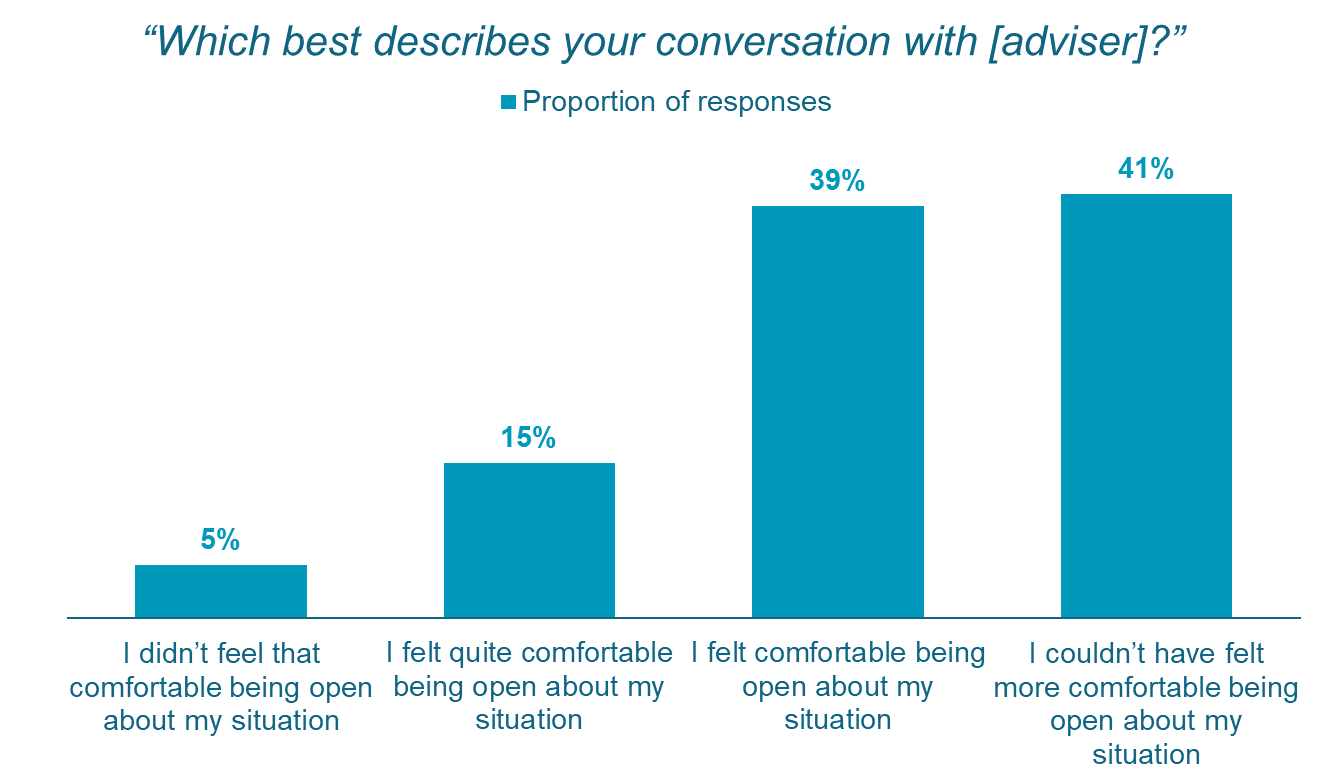Prospects Comfortable Being Open
Prospects comfortable being open is a Driver of Elevation Goal 3: Safeguarding clients’ best interests, mitigating risk
Data based on responses to the following question, asked in the First Impression review form
“Which best describes your conversation with [adviser]?”
Possible responses
I didn’t feel that comfortable being open about my situation
I felt quite comfortable being open about my situation
I felt comfortable being open about my situation
I couldn’t have felt more comfortable being open about my situation
Prospect Comfortable Being Open Score
Proportion of respondents answering “I couldn’t have felt more comfortable being open about my situation”, or “I felt comfortable being open about my situation”
Distribution of responses to Prospect Comfortable Being Open
Why do we ask about Prospect Comfortable Being Open?
Prospects feeling comfortable enough to be open with their adviser early in the relationship allows the adviser to build a strong picture of the client’s situation and needs from early on, supporting them to set clear expectations.
How to improve your score:
The importance of change
Keeping up to date. Make sure your client knows that their plan is based on their current circumstance and if this changes at any point, you may need to vary the plan. For this reason, it’s important that they let you know, no matter how minor they may think the change is.
Notifying you. Ensure your clients are clear on how to tell you about changes. Should they call your mobile, call the office, or just update their details on their client portal? Being clear on how your clients should contact you takes away a barrier by stopping them wondering how best to get in touch.
Starting your conversations
Establish Rapport. Rapport extends beyond small-talk. Finding genuine common ground to talk about which connects you to your client. In each interaction with your client, spend time talking about what’s important to them. This could be their family, a recent important event or how their football team did at the weekend. The key is to make them feel that your relationship is more than transactional.
Beware starting your conversation with money. This can be an immediate turn off for your prospective clients and risks a superficial conversation preventing you from understanding your client’s real motivation.
Sincerity is key. Ask your client how they are and be genuinely interested in their response. Asking how someone is and then saying “great, so let’s get on with things” shows your question was insincere, killing rapport.
Make it personal
Relevant to them. If you’ve established good rapport, your client will tell you about what’s going on in their life. You can use this to frame their progress in line with their life goals.
Events and milestones. Make a note of key events (ideally in your CRM system) and ask your client about them the next time you speak to them.
Touching base. Set a reminder/diary note for you to contact them around special events (retirement, child’s graduation, amazing holiday). Give them a call specifically to ask about the event – don’t talk about business at all in the call.
Active listening. Being conscious of your behaviour and body language when your client is talking. Active listening is a great way to show your client that you’re interested in what they have to say.
The “5 Whys”. This is a helpful and simple tactic, where you ask why 5 times to the initial answer your client has given to get to their real motivation. For example:
“I want to invest £100,000” – why? / “I want the money to grow” – why?
Be honest, be you
Be authentic. It’s easy to try and put on a “work persona” when with clients. Whilst this may come across very professional, it’s not you, and people buy into people. Be authentically yourself in all your engagements.
Own mistakes. Don’t try to cover them up. If you’ve forgotten to ask for something, it’s much better to be honest. People connect more with others who are able to show vulnerability so by being honest, you’re likely to build a deeper relationship with your client.
Be Open. Share some information about your life, including any challenges. We’re not talking about a full therapy session, however sharing shows you to be authentic. If your client feels that you’re being open about your life, they’ll feel more comfortable being open about theirs.
Validating understanding
Reinforce & Validate. Check your understanding regularly with your client. Say “So let me just check I’ve understood that correctly” and then repeat back what your client has just told you. This reinforces that you are interested in them as you want to ensure you get everything right.
Using these methods, you’ve got a much greater chance of your client feeling comfortable about being open with you and getting the information you need to create good outcomes, mitigating against risk and avoiding misunderstanding, recommending the wrong products or services and future complaints.

